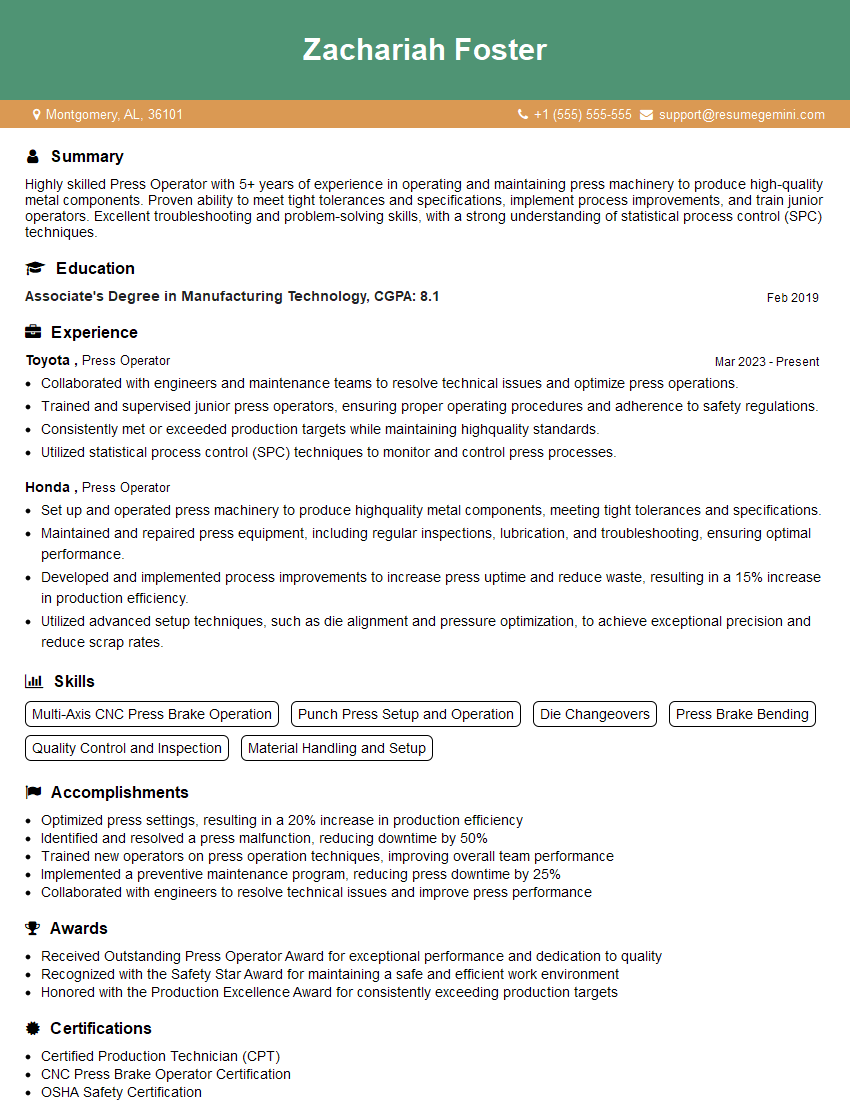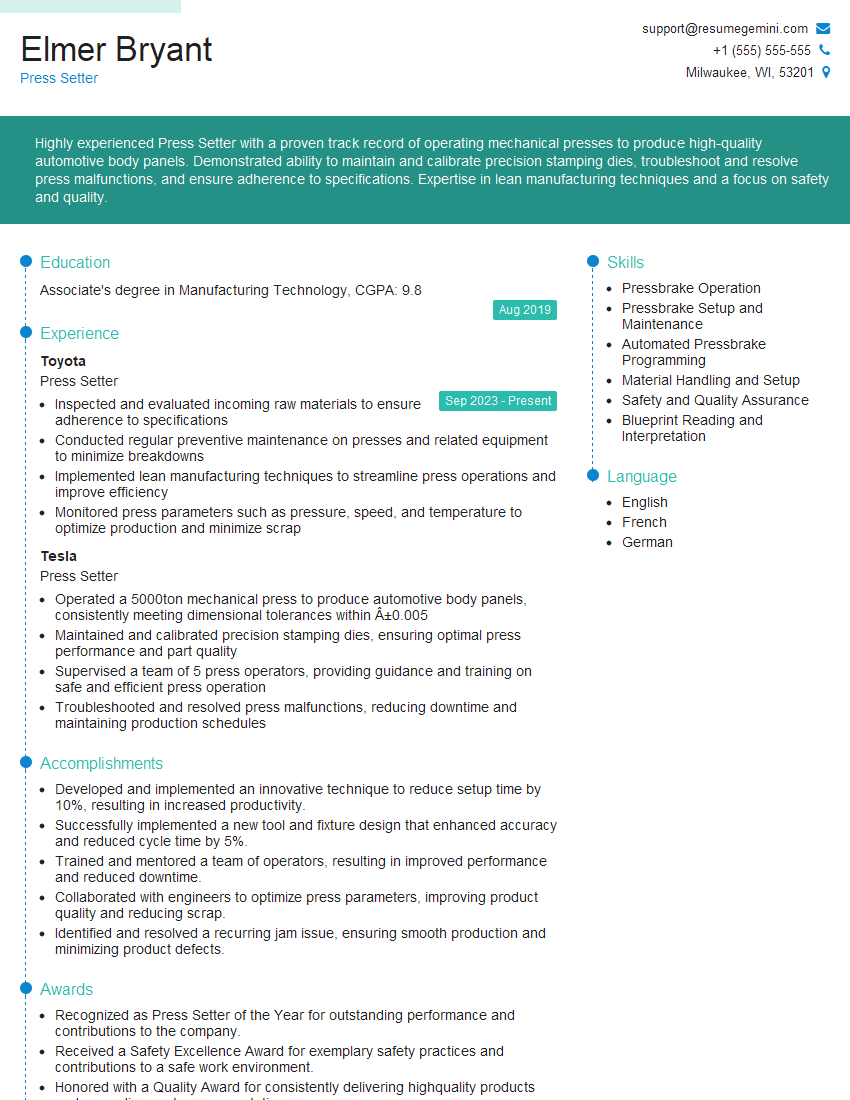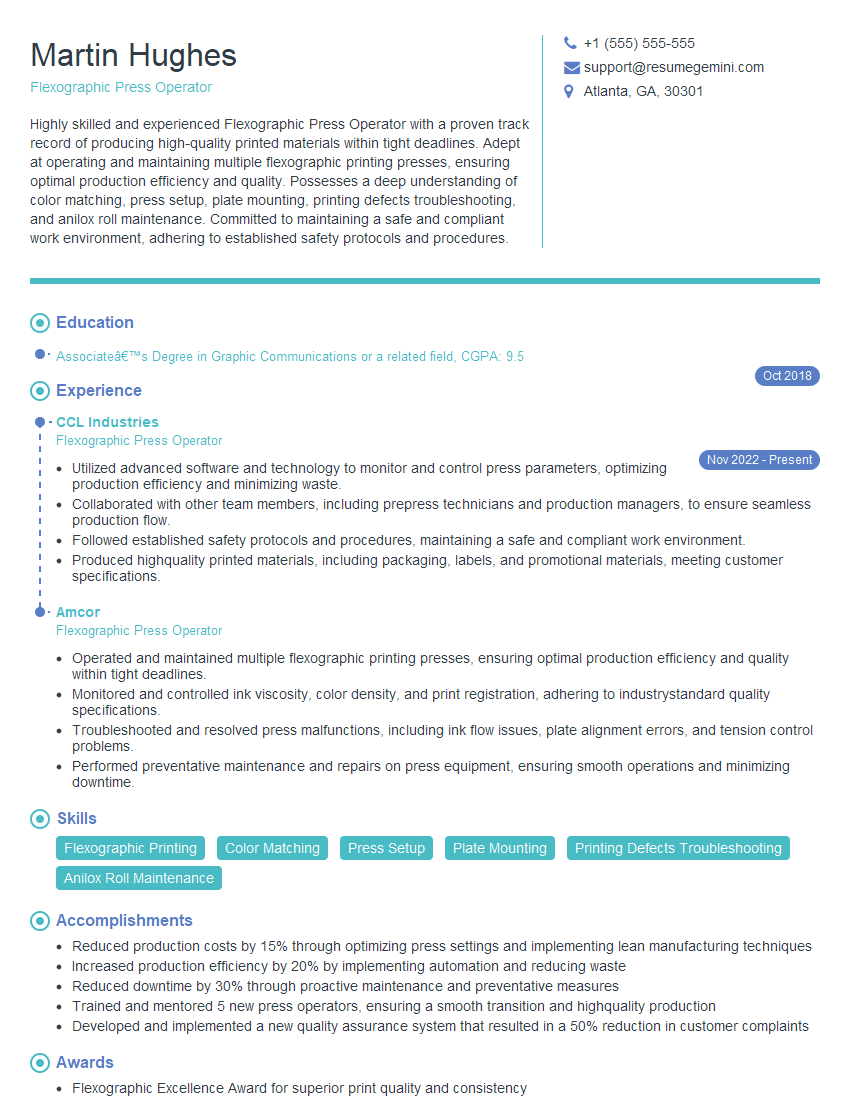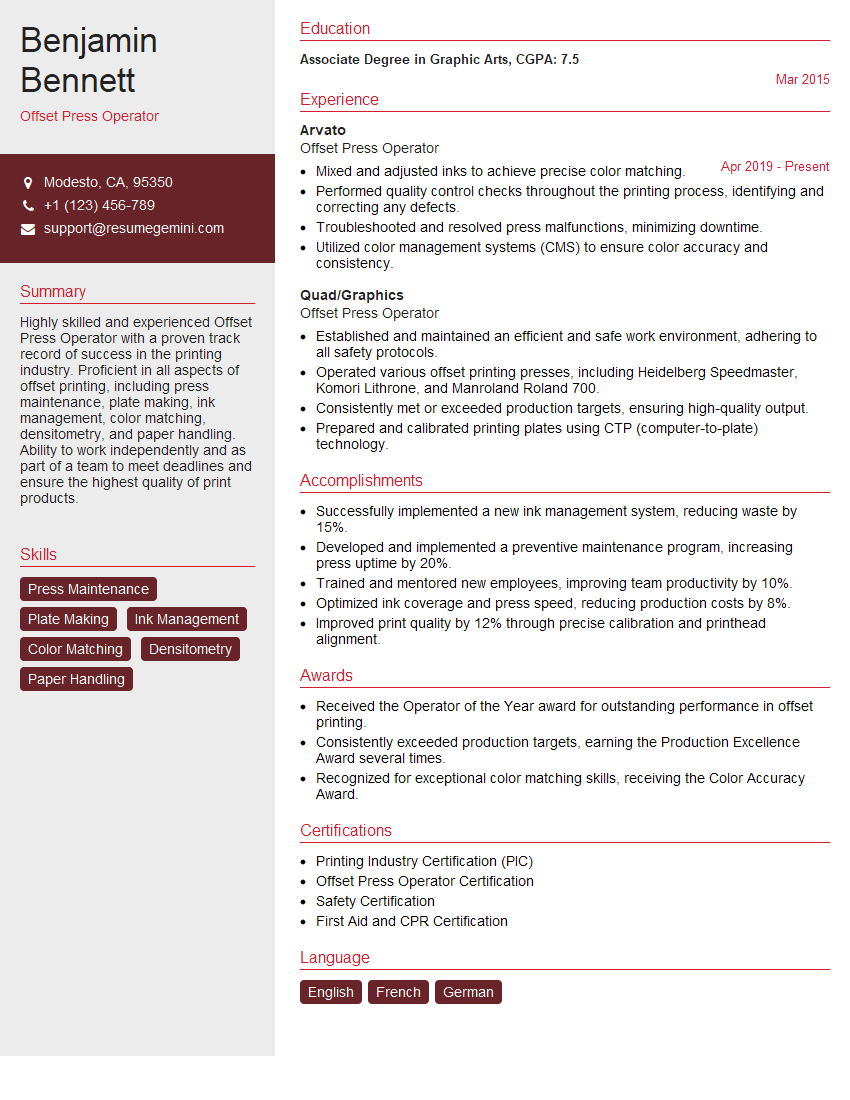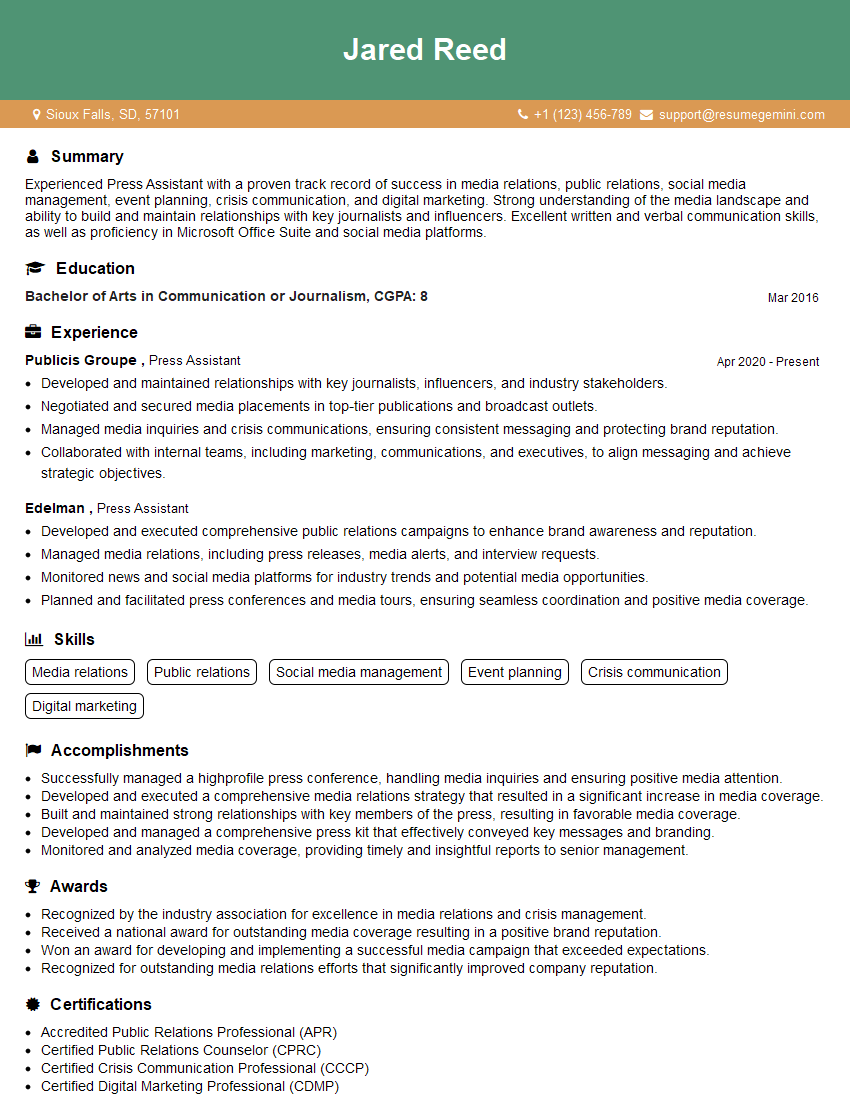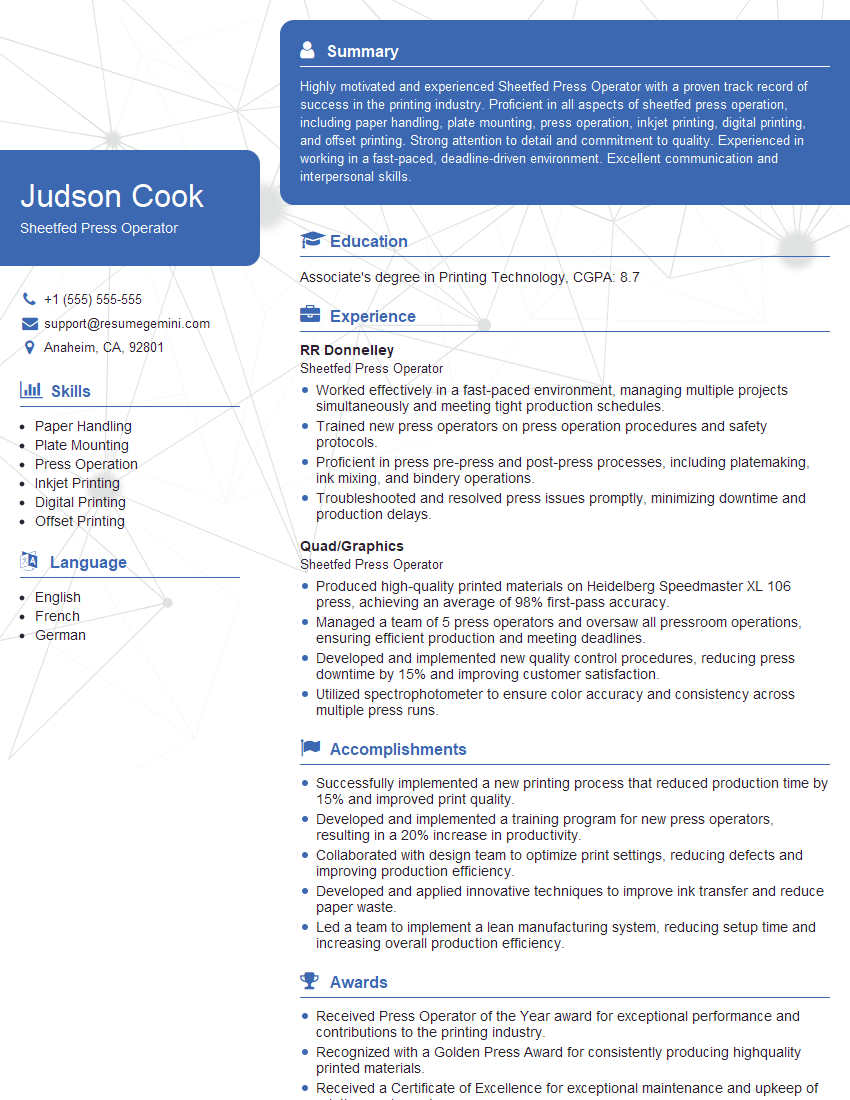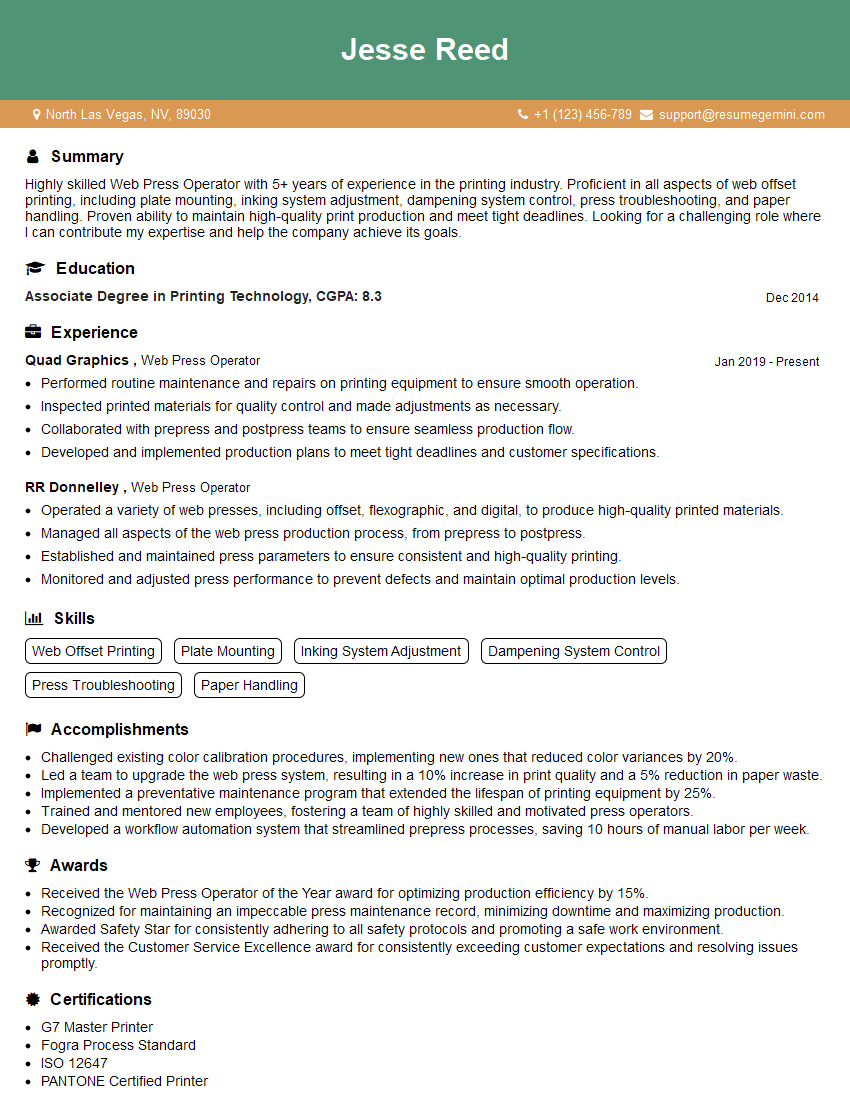Feeling uncertain about what to expect in your upcoming interview? We’ve got you covered! This blog highlights the most important Press Adjustments interview questions and provides actionable advice to help you stand out as the ideal candidate. Let’s pave the way for your success.
Questions Asked in Press Adjustments Interview
Q 1. Explain the process of adjusting ink density on an offset press.
Adjusting ink density on an offset press is crucial for achieving the desired color and vibrancy in your print. It’s a delicate balance, and the process involves manipulating several factors. Think of it like controlling the flow of water from a faucet – you need the right amount for the perfect outcome.
Firstly, we examine the current ink density using a densitometer, a device that measures the optical density of the ink. This gives a quantifiable value we can compare to our target. Then, we adjust the ink keys (usually located on the ink fountains or rollers), increasing or decreasing the amount of ink flowing onto the rollers. Small adjustments are key; even minor tweaks can make a significant difference. We then run a test sheet and re-measure the density, iterating the process until the desired density is achieved. This often involves adjusting the ink duct settings which control the amount of ink transferred to the rollers and finally to the plate. For example, if the print is too light, we might increase the ink key setting on the relevant color unit. Additionally, the ink viscosity plays a vital role, and adjustments to temperature and fountain solution can also affect density.
Beyond the basic settings, factors like the type of ink, paper stock, and press speed all influence ink density. Experience teaches you how to anticipate these variables and compensate accordingly. For instance, thicker papers may absorb more ink, requiring an adjustment to the ink keys to maintain the desired density.
Q 2. How do you identify and resolve register problems on a printing press?
Register problems, where the colors or images don’t align perfectly, are a common headache in printing. Imagine trying to put together a jigsaw puzzle with slightly misaligned pieces – the final image is compromised. Identifying the problem involves carefully examining the printed sheet, noting where misregistration occurs and on which color it is most apparent.
We use a register gauge to precisely measure the misalignment. This allows for a systematic approach to adjustment. Resolution involves tweaking the lateral and longitudinal adjustments on each printing unit, carefully moving the plates or cylinders to achieve perfect alignment. These adjustments are incredibly precise, often requiring adjustments measured in thousandths of an inch. The process is iterative – we make a small adjustment, run a test sheet, measure, and adjust again until the desired register is achieved. Sometimes, this involves adjusting the grippers and sidelays to ensure the paper is fed correctly, preventing misalignment at the very beginning. For example, a consistent misregistration across the whole sheet usually points to a gripper or feeder issue. While a misregistration that only occurs at one edge points to a problem with that edge’s sidelays.
Q 3. Describe your experience with different types of press adjustments (e.g., impression, ink, cut-off).
My experience spans a wide range of press adjustments, and I’m comfortable working on various press models.
- Impression adjustments involve fine-tuning the pressure between the printing plate and the blanket cylinder. Too little pressure leads to light prints and poor ink transfer; too much leads to crushing the paper and damaging the plate. I’ve worked extensively on adjusting impression cylinders to achieve optimal contact pressure for different paper stocks.
- Ink adjustments, as previously discussed, encompass ink density, but also ink distribution, trapping (how different colors transfer and interact with each other), and viscosity. My proficiency extends to troubleshooting various ink-related issues such as mottling and uneven ink distribution.
- Cut-off adjustments concern the precise trimming of the printed sheet. Incorrect cut-off can lead to inconsistencies in sheet size and affect binding or finishing. I’ve used various methods for diagnosing and correcting cut-off problems, including adjusting the knives, side guide settings, and ensuring the accuracy of the cutter mechanism.
I have experience across both Heidelberg and Komori presses, and adjusting these requires specialized understanding of the specific machine parameters.
Q 4. What are the common causes of slurring on a printing press, and how do you fix them?
Slurring, that fuzzy or blurry appearance in the print, is often caused by several factors. It’s like trying to write with a slightly smudged pen.
- Incorrect impression: Too much pressure can smudge the ink, leading to blurring. Adjusting the impression cylinder to the proper pressure can fix this.
- Ink viscosity: If the ink is too thin, it can spread and blur. Adjusting the ink’s viscosity through temperature control and the addition of additives is necessary.
- Dampening solution: An imbalance in dampening solution can cause slurring. Too much can make the ink run; too little can cause it to dry too quickly on the plate.
- Roller condition: Worn or damaged rollers cannot consistently transfer the ink smoothly. Replacing or cleaning the rollers is needed.
- Plate issues: A damaged or worn printing plate will also lead to slurring. Replacing the plate is the fix.
Troubleshooting slurring requires systematically eliminating these possibilities. I start by inspecting the rollers, examining the dampening system, and measuring the impression pressure. Then, I test sheets and make adjustments until the slurring disappears.
Q 5. How do you maintain consistent color throughout a long print run?
Maintaining consistent color throughout a long print run is paramount. It’s like baking a cake – you want each slice to taste the same. Several steps are crucial:
- Color management: Start with a well-defined color profile and consistent color standards (e.g., using Pantone or other color systems).
- Regular color checks: Perform regular checks (e.g., every 100-200 sheets, depending on the job) using a densitometer to measure the ink densities of each color. This allows for early detection of discrepancies.
- Ink temperature control: Maintaining consistent ink temperature ensures viscosity remains stable.
- Dampening system monitoring: Regular monitoring and adjustment of the dampening system ensures the paper is consistently prepared for ink reception.
- Proper press maintenance: Keeping the press well-maintained, including cleaning rollers and changing plates at regular intervals, prevents wear and tear that could impact color consistency.
- Regular adjustments: Small adjustments to ink keys and dampening solution may be needed over the run as the ink and paper conditions gradually change.
Consistent color is about proactive management and attention to detail. Experienced press operators know how to anticipate potential color shifts and adjust accordingly.
Q 6. Explain your experience with maintaining press registration.
Maintaining press registration is an ongoing process demanding precision and patience. My experience involves consistently monitoring the register throughout the print run, identifying and correcting discrepancies before they become major issues. Early intervention is vital. This begins with accurate setup before starting the print job, which involves careful alignment of the plates. During the run, I use register gauges to perform regular checks and make minor adjustments on the press controls as needed. This might involve adjusting the sidelays, grippers or the register controls on each individual printing unit. I am comfortable with various techniques, including using a variety of register gauges and systematically addressing any shifts in alignment, such as those that may occur due to paper variations or temperature changes in the print environment.
One memorable instance involved a long print run with a particularly challenging paper stock. The paper’s tendency to expand slightly as it absorbed moisture posed a constant threat to registration. Through careful monitoring and small, incremental adjustments throughout the run, we were able to maintain perfect registration and deliver a flawlessly printed product.
Q 7. How do you troubleshoot paper jams on various press types?
Troubleshooting paper jams requires a systematic approach, varying slightly depending on the press type. However, the underlying principles remain consistent. First, I turn off the press and ensure it is safe to access before investigating.
Common Causes and Solutions:
- Misaligned paper guides: Improperly adjusted paper guides can cause jams. Carefully realign the guides to ensure the paper feeds smoothly. This often involves tightening screws or moving levers.
- Paper defects: Damaged or improperly cut paper can jam the press. Inspect the paper stack for defects and remove any damaged sheets.
- Roller issues: Worn, damaged, or dirty rollers can prevent proper paper movement. Clean or replace the rollers as needed.
- Suction issues: Problems with the paper feed suction system can cause jams. Check suction settings and ensure that there are no blockages.
- Gripper bar issues: Malfunctioning grippers can fail to correctly grip the paper, causing jams. Inspect the gripper bar and ensure that all grippers are correctly engaged and that there is no debris blocking them.
The process begins with identifying the location of the jam (e.g., feeder, inking unit, delivery system), then carefully removing the jammed paper. After clearing the jam, I’ll inspect the surrounding areas to ensure there’s nothing else causing a potential problem. Only then do I turn the press back on to resume printing. Experience helps in quickly diagnosing the cause – often a visual inspection combined with knowledge of the press’s mechanics is sufficient to solve the problem.
Q 8. What safety procedures do you follow when performing press adjustments?
Safety is paramount when making press adjustments. Before even touching the press, I always ensure I’ve completed a thorough lockout/tagout procedure to prevent accidental activation. This involves turning off power, locking the main power switch, and tagging it clearly indicating that maintenance is in progress. I then perform a visual inspection for any obvious hazards like loose parts or exposed wiring.
Wearing appropriate personal protective equipment (PPE) is non-negotiable – this includes safety glasses to protect against flying debris, hearing protection to reduce noise exposure, and sturdy, closed-toe shoes. I’m also mindful of the press’s moving parts and maintain a safe distance from pinch points and other potentially hazardous areas. Finally, I work methodically and never rush through adjustments. Safety is not a suggestion; it’s a core principle.
Q 9. Describe your experience with different types of printing presses (e.g., offset, flexo, digital).
My experience spans various printing press types. I’ve extensively worked with offset presses, both sheetfed and web, mastering adjustments for color registration, ink density, and impression. I’m adept at handling different sheet sizes and paper types. With flexographic presses, I’m proficient in anilox roll adjustments, ink viscosity control, and plate cylinder registration, critical for high-volume packaging printing. I also have experience with digital presses, focusing on calibration and maintenance, understanding their unique requirements for image quality and consistency. For example, I once resolved a significant color banding issue on a digital press by adjusting the fusing unit temperature and pressure, a solution that required careful analysis and adjustments specific to that model.
Q 10. How do you perform a pre-press inspection?
A thorough pre-press inspection is crucial for a successful print run. I start by meticulously verifying the artwork against the proof, checking for accurate color reproduction, image placement, and text integrity. This often involves using a densitometer to measure color values and ensure they are within acceptable tolerances. I examine the plates or printing plates, looking for any damage, defects, or inconsistencies that could affect the final print. Then, I examine the paper stock for flaws, checking for consistency in texture, weight, and moisture content. Finally, I conduct a press test run using a small number of sheets, carefully evaluating image quality, registration, and ink density. By finding and fixing small issues early, we prevent major problems during the main run – and save a lot of time and materials in the long run.
Q 11. How do you handle different paper stocks during press adjustments?
Different paper stocks require different press adjustments. Heavier stocks necessitate greater impression pressure to ensure proper ink transfer and avoid slurring. Lighter stocks, on the other hand, require less pressure to avoid damaging the paper. Moisture content significantly impacts paper behavior; high moisture can lead to stretching and registration issues, requiring adjustments to the press’s dampening system and rollers. I account for these variables by consulting the paper supplier’s specifications and making incremental adjustments to pressure, dampening, and feed settings. For instance, when switching from a light uncoated paper to a heavy coated stock, I systematically increase the impression, carefully monitoring for proper ink transfer and image sharpness, making small adjustments until the optimum print quality is achieved.
Q 12. How familiar are you with color management systems (e.g., Pantone, G7)?
I’m very familiar with color management systems like Pantone and G7. Pantone provides a standardized color language, ensuring consistency across different printing processes and locations. I regularly use Pantone color swatches to match and verify ink colors. G7 is a calibration method for achieving a neutral print, improving consistency across different substrates. My understanding of these systems allows me to set up color profiles, adjust ink densities, and maintain consistent color throughout a print run. For example, if there’s a significant color shift during a print job, I will use the densitometer and spectrophotometer, along with G7 guidelines to identify the cause and make the necessary adjustments to achieve color consistency, ensuring the final product meets the client’s specifications.
Q 13. What are the common causes of hickeys and how do you prevent them?
Hickeys, those annoying little blemishes on a print, are typically caused by foreign objects like dust, fibers, or dried ink sticking to the printing plate or blanket. Prevention is key. This involves maintaining a clean and dust-free printing environment. Thoroughly cleaning the plates and blankets regularly removes debris and reduces the risk of hickeys. Using high-quality inks and ensuring proper ink viscosity also minimizes their occurrence. I also perform regular inspections of the press for any potential sources of contamination. For example, if I notice a recurring cluster of hickeys in a specific area, I’ll check the plate, blanket, and the surrounding components for any trapped particles. Careful attention to detail during setup and throughout the printing process is the most effective hickey prevention strategy.
Q 14. How do you adjust the impression on a printing press?
Impression adjustment fine-tunes the pressure between the printing plate and the paper. It’s crucial for optimal ink transfer and print quality. Too little impression results in light, weak prints; too much causes excessive ink transfer and paper damage. I adjust the impression using the press’s impression controls, typically screws or levers. I start with a test run using a small number of sheets at a low impression, then gradually increase it in increments, carefully inspecting the prints after each adjustment. The goal is to find the ‘sweet spot’ where the ink transfers clearly and completely without leaving an excessive or uneven impression on the paper. The process is iterative. I frequently compare the output to the proof to ensure the results are as expected. Proper impression settings depend on the paper type and the ink used and I adjust accordingly.
Q 15. What methods do you use to ensure proper ink distribution?
Proper ink distribution is crucial for consistent print quality. It ensures even color coverage and prevents issues like streaks, mottle, or poor image sharpness. We achieve this through a multi-pronged approach:
Ink Roller Settings: The ink rollers’ durometer (hardness) and pressure are meticulously adjusted. Too soft, and they’ll pick up too much ink; too hard, and they won’t pick up enough. We fine-tune these settings based on the ink viscosity and the desired ink density. For example, printing vibrant colors might require softer rollers and slightly higher pressure compared to a subtle pastel.
Fountain Roller Settings: These rollers deliver ink to the ink rollers. Their pressure and position must be precisely calibrated to ensure a consistent ink flow. Improper settings can lead to ink starvation or excessive ink build-up on the rollers.
Ink Temperature: Ink viscosity is highly temperature-dependent. Maintaining optimal ink temperature is vital. Too cold, and the ink becomes thick and sluggish; too hot, and it can become too thin and runny. Many presses have integrated ink temperature control systems which we monitor closely.
Regular Cleaning: We regularly clean the rollers, fountain solution system and ink ducts to prevent buildup and ensure even ink transfer. This includes removing any dried ink or debris that might interfere with the flow.
Career Expert Tips:
- Ace those interviews! Prepare effectively by reviewing the Top 50 Most Common Interview Questions on ResumeGemini.
- Navigate your job search with confidence! Explore a wide range of Career Tips on ResumeGemini. Learn about common challenges and recommendations to overcome them.
- Craft the perfect resume! Master the Art of Resume Writing with ResumeGemini’s guide. Showcase your unique qualifications and achievements effectively.
- Don’t miss out on holiday savings! Build your dream resume with ResumeGemini’s ATS optimized templates.
Q 16. How do you calculate and adjust the correct cut-off on a printing press?
The cut-off on a printing press determines the final size of the printed sheet. Incorrect cut-off can lead to significant waste and production errors. We calculate the correct cut-off by considering several factors:
Job Specifications: The client’s specifications clearly state the required dimensions of the finished product. These dimensions are the starting point for our calculations.
Paper Size: We measure the actual size of the paper roll or sheets being used. Any variation from the nominal size needs to be accounted for.
Gripper Margin: The grippers hold the paper during printing. We need to factor in the space needed for the grippers to securely grip the paper without interfering with the print area.
Side Guides: These guides ensure accurate paper positioning. We consider their width and position in our cut-off calculations.
Adjustments are made using the press’s control panel. This often involves making precise adjustments to the position of the cutting cylinder or other mechanisms. We use both the press’s electronic controls and physical measurement tools such as micrometers for verification.
Q 17. Explain your process for cleaning and maintaining printing press components.
Cleaning and maintenance are paramount to prevent press downtime and ensure consistent print quality. Our process involves:
Daily Cleaning: At the end of each shift, we thoroughly clean the inking system, dampening system, and blanket cylinders. We use appropriate cleaning solutions and tools specific to each component. We pay close attention to areas prone to ink build-up.
Weekly Maintenance: More extensive cleaning is done weekly. This includes checking and adjusting bearing lubrication, inspecting belts and rollers for wear and tear, and performing a more in-depth cleaning of the entire press.
Preventive Maintenance: Scheduled preventive maintenance involves inspections of critical components, replacement of worn parts, and potentially more advanced cleaning tasks such as ultrasonic cleaning of delicate components.
Documentation: We maintain meticulous records of all cleaning and maintenance activities. This ensures accountability, facilitates troubleshooting, and helps us schedule future maintenance tasks.
We use a combination of specialized cleaning solutions, brushes, rags, and other tools designed for use on printing presses.
Q 18. How do you diagnose and correct issues with blanket wear?
Blanket wear is a common issue that can negatively impact print quality. Diagnosing the problem involves inspecting the blanket for various signs of wear, such as:
Scratches or Cuts: These can be caused by debris in the paper or improper handling.
Uneven Wear: This indicates potential problems with the press’s impression cylinder, blanket cylinder alignment, or improper blanket mounting.
Compression Set: This is a loss of elasticity, causing poor ink transfer and uneven print.
Correction involves identifying the root cause. If it’s just minor scratches or surface wear, we can often repair it with appropriate blanket cleaner and conditioning products. More serious issues necessitate blanket replacement. When installing a new blanket, we ensure proper mounting and alignment to avoid repeating the problem.
Q 19. Describe your experience working with different types of inks.
I have extensive experience with various ink types, including:
UV Inks: These inks cure instantly upon exposure to UV light, offering fast drying times and vibrant colors. They are suitable for a wide variety of substrates but require specialized UV curing units.
Water-Based Inks: Environmentally friendly, these inks are popular for their lower environmental impact. However, they have slower drying times and require careful control of moisture levels.
Solvent-Based Inks: These inks offer excellent adhesion and vibrant colors but can have a stronger odor and require careful handling due to the volatile organic compounds (VOCs).
Vegetable-Based Inks: A more sustainable alternative to traditional inks, offering similar performance with a lower environmental footprint.
My experience encompasses adjusting press settings, such as ink viscosity and flow, based on the specific properties of each ink type. Each ink requires a unique approach to ensure optimal print results.
Q 20. How do you monitor and control moisture levels during printing?
Moisture control is especially critical when using water-based inks or printing on paper susceptible to changes in humidity. We monitor and control moisture levels through several methods:
Dampening System: We adjust the dampening solution’s concentration and flow to maintain the proper level of moisture on the paper. Too little moisture leads to poor ink transfer, while too much can cause the ink to smear or feather.
Environmental Control: The pressroom environment is maintained within an optimal temperature and humidity range. Excessive humidity can cause the paper to swell and create problems with registration and ink transfer, while low humidity can cause the paper to become brittle.
Paper Handling: We take care to prevent paper from absorbing excess moisture from the air. This might involve using appropriate storage and handling techniques.
Monitoring Devices: We use hygrometers to precisely measure the relative humidity in the pressroom and adjust the environmental controls accordingly.
Maintaining optimal moisture levels is a delicate balancing act, and experience plays a significant role in achieving consistent print quality.
Q 21. What software or systems do you use to monitor press performance?
Modern printing presses often incorporate sophisticated software and systems for press performance monitoring. We utilize various systems including:
Press Control Systems: These systems provide real-time data on press parameters such as speed, ink density, moisture levels, and other critical metrics. This allows for proactive adjustments to optimize performance.
Data Acquisition Systems: These systems collect and analyze press data to identify trends, predict potential issues, and improve overall efficiency. This data is used for preventative maintenance and optimizing press settings.
Color Management Software: We use color management software to ensure consistent color reproduction across different jobs. This software helps to accurately profile the press and manage color variations.
Reporting and Analytics Dashboards: These dashboards provide a clear overview of press performance, identifying areas for improvement and facilitating data-driven decision-making.
The specific software and systems used vary depending on the type of press and the printing company’s infrastructure, but the core goal remains the same: to achieve maximum efficiency and consistent high-quality output.
Q 22. Describe a time you had to troubleshoot a complex press problem.
One time, we experienced significant color inconsistencies across a large print run of brochures. The initial suspect was the ink, but after careful testing, we ruled that out. The problem was actually a subtle variation in the pressure across the printing cylinder, caused by a slightly worn roller. Troubleshooting involved a systematic approach:
- Visual Inspection: We carefully examined the rollers and the blanket cylinder for any signs of wear or damage. We noticed a slight flattening on one section of the roller.
- Pressure Readings: Using pressure gauges, we took precise measurements across the entire printing cylinder to confirm the pressure inconsistencies. The data pinpointed the area of the problem.
- Roller Adjustment: We then made minute adjustments to the roller pressure using the press’s controls, carefully monitoring the pressure readings to ensure even distribution. We also added shims to support the flattened area to distribute the pressure evenly.
- Test Prints: After each adjustment, we ran test prints to evaluate the color consistency. This iterative process allowed us to fine-tune the pressure until the desired uniformity was achieved.
- Root Cause Analysis: Once the problem was resolved, we documented the issue and the solution to prevent similar occurrences in the future. We scheduled the worn roller for replacement as a preventative measure.
This experience underscored the importance of meticulous attention to detail and the value of systematic troubleshooting in press operations.
Q 23. How do you ensure the quality of your press adjustments?
Ensuring the quality of my press adjustments relies on a multi-faceted approach. It’s not just about making the adjustments; it’s about verifying their effectiveness and consistency.
- Pre-Press Checks: Before even touching the press, I meticulously review the job specifications – ensuring the correct plates, inks, substrates, and printing parameters are used. This preventative step minimizes potential issues.
- Regular Monitoring: During the print run, I constantly monitor the output, checking for color consistency, registration accuracy, and ink density. I frequently take test prints to detect subtle changes.
- Instrumentation: I utilize colorimeters and densitometers to objectively measure color values and ink density. This provides quantifiable data that guides adjustments and ensures consistent results.
- Documentation: I maintain detailed records of all adjustments made, including the time, adjustments made, and the resulting output. This facilitates troubleshooting and helps identify trends.
- Visual Inspection: A keen eye is crucial. I constantly inspect the printed sheets for defects like dot gain, slurring, or color inconsistencies. Early detection minimizes waste.
By combining these methods, I ensure that my press adjustments maintain high quality, consistency, and efficiency throughout the printing process.
Q 24. What is your experience with press automation and controls?
My experience with press automation and controls is extensive. I am proficient in operating presses equipped with sophisticated computer-aided systems for controlling ink, pressure, and speed. I understand various control systems, such as PLC-based controls, and am comfortable working with touch screens and operator interfaces. For example, I’ve worked extensively with Heidelberg’s Prinect Press Center and other similar control systems.
This includes:
- Automated color control: Experience in setting up and maintaining automated color control systems that automatically adjust ink levels to maintain consistent color output.
- Automated register control: Proficiency in using automated register systems to accurately align colors and images for precise printing.
- Predictive maintenance: Familiarity with press control systems that provide data for predictive maintenance, allowing for proactive identification of potential problems before they occur.
Understanding these automated systems is crucial for optimizing press performance and reducing waste.
Q 25. How do you handle emergencies or unexpected issues on the press?
Handling emergencies requires a calm, methodical approach. My first priority is always safety.
- Assess the Situation: Quickly determine the nature and severity of the problem. Is it a mechanical issue, an ink problem, or a paper jam?
- Safety First: Ensure the press is safely shut down and that all personnel are clear of the immediate danger.
- Troubleshooting: Systematically troubleshoot the issue based on my knowledge and experience. This may involve checking sensors, circuits, or mechanical components.
- Seek Assistance: If the problem is beyond my expertise, I immediately contact the appropriate maintenance personnel or supplier. Clear communication is critical.
- Documentation: Following the resolution, the issue and solution are documented to aid in preventative maintenance and to prevent future occurrences.
One example: A sudden power surge caused a major press malfunction. I immediately shut down the press, contacted the electrician, and documented the event. We prevented further damage by following the established emergency procedures.
Q 26. What are your methods for optimizing press speed and efficiency?
Optimizing press speed and efficiency is a continuous process, focusing on both preventative measures and real-time adjustments.
- Preventative Maintenance: Regular maintenance prevents downtime and maximizes uptime. This includes routine cleaning, lubrication, and inspections.
- Waste Reduction: Minimizing makeready waste through efficient plate mounting and careful pre-press preparation is crucial.
- Paper Handling: Proper paper handling and adjustments to the feeder system prevent jams and maintain a consistent flow of substrate.
- Ink Optimization: Fine-tuning ink settings, including ink viscosity and flow, directly impacts print quality and speed. This is monitored via densitometer readings.
- Press Control System Utilization: Leveraging the press’s automation features, such as automated color and register controls, reduces manual intervention and increases speed.
By focusing on these areas, we can consistently improve press throughput and reduce operational costs.
Q 27. Describe your understanding of different types of printing plates.
My understanding of printing plates encompasses their various types, their properties, and their applications. The choice of plate significantly impacts print quality, press efficiency, and cost. Here are some common types:
- Letterpress Plates: These raised-image plates are used in letterpress printing, creating a very tactile and unique print.
- Flexographic Plates: Used for flexible packaging and labels, these photopolymer plates are known for their durability and ability to print on various substrates.
- Offset Plates: These are the most widely used type, for offset lithography, and come in different materials, including aluminum and polymer plates, each with different properties affecting print quality and durability. Some are designed for specific inks or substrates.
- Gravure Plates: These etched plates are used for high-volume printing with consistent results, especially for magazines or packaging requiring high-quality images.
Selecting the appropriate plate is critical for achieving optimal print quality and minimizing waste, so understanding their differences is crucial for efficient press operation.
Q 28. How do you contribute to a safe and productive pressroom environment?
Contributing to a safe and productive pressroom environment is a top priority. This involves adherence to safety regulations, proactive problem-solving, and teamwork.
- Safety Procedures: I strictly adhere to all safety procedures, including lockout/tagout procedures when working on the press, wearing appropriate personal protective equipment (PPE), and regularly inspecting the press for potential hazards.
- Preventative Maintenance: Regularly scheduled maintenance minimizes the risk of accidents by preventing mechanical failures and ensuring smooth operation.
- Cleanliness and Organization: Maintaining a clean and organized pressroom significantly improves safety and workflow efficiency. A clutter-free environment reduces trip hazards and makes it easier to identify potential problems.
- Teamwork: Effective communication and collaboration with colleagues are crucial for maintaining a safe and productive environment. Open communication about potential hazards and problem-solving approaches is essential.
By actively promoting safety and efficiency, we foster a positive and productive work environment that prioritizes both output and the well-being of everyone involved.
Key Topics to Learn for Press Adjustments Interview
- Understanding Color Registration: Mastering the principles of accurate color matching and the adjustments needed to achieve consistent print quality across multiple colors.
- Ink Density and Dot Gain: Learn how to adjust ink density to achieve the desired color saturation while understanding and mitigating the impact of dot gain on print results.
- Paper and Substrate Considerations: Explore how different paper types and substrates affect ink absorption and color reproduction, and how to adjust press settings accordingly.
- Troubleshooting Common Press Issues: Develop practical problem-solving skills to diagnose and resolve issues such as color inconsistencies, slurring, and mottle.
- Press Controls and Automation: Familiarize yourself with the operation of modern printing presses, including automated adjustments and quality control systems.
- Print Quality Standards and Specifications: Understand industry-standard metrics for evaluating print quality, such as color accuracy, sharpness, and consistency.
- Prepress and Postpress Considerations: Understand the relationship between press adjustments and the processes that occur before (prepress) and after (postpress) printing.
- Safety Procedures and Best Practices: Demonstrate knowledge of safe operating procedures and best practices related to press operation and maintenance.
Next Steps
Mastering press adjustments is crucial for career advancement in the printing industry, opening doors to higher-paying roles and increased responsibility. A strong understanding of these concepts showcases your technical expertise and problem-solving abilities, making you a highly sought-after candidate. To further enhance your job prospects, create an ATS-friendly resume that highlights your skills and experience effectively. ResumeGemini is a trusted resource that can help you build a professional resume that gets noticed. Examples of resumes tailored to Press Adjustments are available to guide you through the process.
Explore more articles
Users Rating of Our Blogs
Share Your Experience
We value your feedback! Please rate our content and share your thoughts (optional).
What Readers Say About Our Blog
Hello,
We found issues with your domain’s email setup that may be sending your messages to spam or blocking them completely. InboxShield Mini shows you how to fix it in minutes — no tech skills required.
Scan your domain now for details: https://inboxshield-mini.com/
— Adam @ InboxShield Mini
Reply STOP to unsubscribe
Hi, are you owner of interviewgemini.com? What if I told you I could help you find extra time in your schedule, reconnect with leads you didn’t even realize you missed, and bring in more “I want to work with you” conversations, without increasing your ad spend or hiring a full-time employee?
All with a flexible, budget-friendly service that could easily pay for itself. Sounds good?
Would it be nice to jump on a quick 10-minute call so I can show you exactly how we make this work?
Best,
Hapei
Marketing Director
Hey, I know you’re the owner of interviewgemini.com. I’ll be quick.
Fundraising for your business is tough and time-consuming. We make it easier by guaranteeing two private investor meetings each month, for six months. No demos, no pitch events – just direct introductions to active investors matched to your startup.
If youR17;re raising, this could help you build real momentum. Want me to send more info?
Hi, I represent an SEO company that specialises in getting you AI citations and higher rankings on Google. I’d like to offer you a 100% free SEO audit for your website. Would you be interested?
Hi, I represent an SEO company that specialises in getting you AI citations and higher rankings on Google. I’d like to offer you a 100% free SEO audit for your website. Would you be interested?
good
